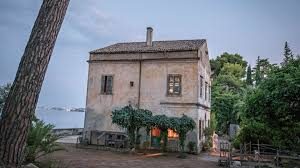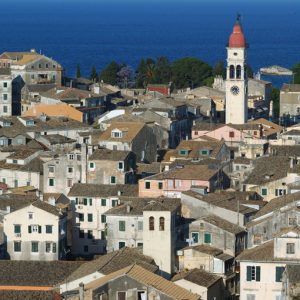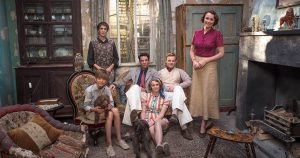The fourth season of The Durrells is underway on ITV1, (Sundays) and is available on catch-up.
The programme, set in the late 1930s, follows Louisa Durrell’s attempt to make a new life for herself and her family in Corfu, after her husband died. The series stars Keeley Hawes, Josh O’Connor, Daisy Waterstone, Milo Parker, Callum Woodhouse, Leslie Caron, Yorgos Karamihos, Alexis Georgoulis and Christopher Sciueref.
Louisa’s youngest son Gerald went on to be an eminent naturalist. The stories in the series are loosely based on his book, My Family and Other Animals, and its sequels. Another son, Lawrence, wrote The Alexandria Quartet and other works.
This is my piece on the island. (A shorter version was published in the Mail on Sunday in May 2016.)
Despite mass tourism, Corfu, the gem of the Ionian, still holds many traces and memories of Gerald Durrell‘s family, and other animals. Its random attractions include cricket, ginger beer and Prince Philip’s birthplace.
 Colour code
Colour code
The Durrells rented three properties (all now privately owned) during their stay, from 1935 to 1939. Little changed from when the family lived there are Villa Cressida, the “Snow White Villa”, above Lake Halikiopoulou, and Villa Anemmoyanni (“Daffodil Yellow Villa”) behind the original stone gateway at Kontokali. The wooden jetty where Sea Cow and Bootle-Bumtrinket tied up is gone, however. The family first stayed at the “Strawberry Pink Villa”, Villa Agazini, above Perama. Although changes mean it no longer fits the description in the book, it is the one villa where you can stay, booking through Airbnb. The other place you can see for yourself is Lawrence Durrell’s villa at Kalami, “set like a dice on a rock”. Today it is a hotel and a taverna. Lawrence’s book Prospero’s Cell is a wonderful evocationn of the island in the 1930s.
Animal magic
The Corfu Gerald Durrell depicts in My Family and other Animals and other books, “where the magic settled over us as gently as pollen” has been a busy tourist island since the 1960s. But corners of his “multi-coloured Lilliput” cling on unscathed away from the crowded beaches. Some of the best places to look are around the little islet of Pondikonissi, the Kanoni Peninsula, and Lake Halikiopoulou and the adjoining Chessboard Fields. These are salt-flats made by the Venetians, where the young writer loved to watch nature. There’s more in the wilder, greener northern part of the island, around Mount Pantokrator. Experts who join the annual wildlife week still compile a rich list of wildlife, from Bonelli’s eagles and swallowtail butterflies to tortoises, and stripe-necked terrapins.https://geralddurrellscorfu.org/
Up Town
 The Old Town of Corfu, dominated by its three fortresses built by the Venetians to guard the narrow gap across to today’s Albania, is a prime example of the well-preserved Mediterranean fortified port. UNESCO cites its architecture for its “outstanding universal value”. After a 400 year rule, the Venetians left their mark in the many surviving neoclassical houses. The Liston, a stretch of elegant covered terraces built in 1807, echoing the Rue de Rivoli in Paris, shows the best of Napoleonic architecture. It was in Saint Spyridon Church, the tallest on Corfu, where Margo Durrell rashly kissed the “beautifully embroidered slippers” (teeming with human germs) of the 7th century relic in The Durrells. In 2007 the municipal gardens by the Esplanade were renamed ‘Bosketto Durrell’ to honour the two writer brothers.
The Old Town of Corfu, dominated by its three fortresses built by the Venetians to guard the narrow gap across to today’s Albania, is a prime example of the well-preserved Mediterranean fortified port. UNESCO cites its architecture for its “outstanding universal value”. After a 400 year rule, the Venetians left their mark in the many surviving neoclassical houses. The Liston, a stretch of elegant covered terraces built in 1807, echoing the Rue de Rivoli in Paris, shows the best of Napoleonic architecture. It was in Saint Spyridon Church, the tallest on Corfu, where Margo Durrell rashly kissed the “beautifully embroidered slippers” (teeming with human germs) of the 7th century relic in The Durrells. In 2007 the municipal gardens by the Esplanade were renamed ‘Bosketto Durrell’ to honour the two writer brothers.
Grand designs
The British ruled Corfu between 1814 and 1864, taking over from Napoleon. The grandest building in their legacy is the Palace of St. Michael and St. George in Corfu Town. The former residence and seat of administration of the British High Commissioner is a fusion of the architecture of Rome and Ancient Greece. Today it is the Museum of Asian Art. Another celebrated island home is Mon Repos in Kerkyra, birthplace of Prince Philip, and now the Museum of Palaeopolis. There are finds here from the ancient city that stood on this spot. In the quiet grounds look for the site of the Temple of Artemis. A pity the separate Archaeological Museum, which displays the temple pediment, is still shut after a long closure for refurbishment.
Not out
In Corfu Town, a familiar sound effect echoes off the Venetian mansions and French colonnades – the thwack of leather on willow, with the occasional strangled “how’dat”. They’ve played cricket (known here as “block and wallop”, fermaro kai issia) since 1823. (There’s a cricket game in series 2 of The Durrells.) Visiting British sailors would take on the islanders on the Napoleonic army parade ground. The moribund game was revived after the Second World War when Britain’s vice-consul appealed for players back home to send spare bats and balls. Today 13 of Greece’s 20 teams are on the island – in 1995 the International Cricket Council admitted Greece largely because of the strength of Corfu cricket – so finding a match to watch should be easy on one of the the five grounds. The most incongruous pitch is on Spianada Square in the Old Town.
Beer break
Ginger beer, tsitsibira, is another, refreshing, legacy of the British. One of the main producers is the Chimarios Family, who have been recreating the authentic, preservative-free 19th century taste since 1920. Another thing we left behind is the kumquat. This small citrus fruit with a bittersweet flavour thrives on the island. They make it into a drink said to be unique to Corfu, kumquat liqueur. Look for chicken with kumquat, especially in some of the quieter tavernas in the villages. Foros, in Old Perithia, the taverna featured by Rick Stein in his Mediterranean Escapes series, does a brilliant Briam, the local dish of potatoes, aubergine, tomatoes, green peppers onions, and parsley, with olive oil.

